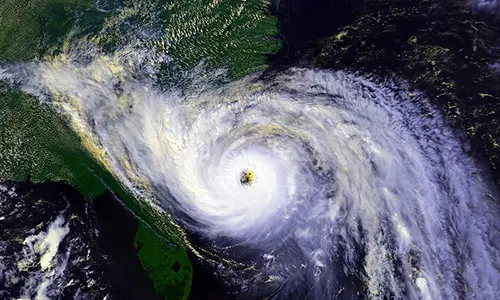Hazel, Audrey, Donna, Hugo, Andrew, Gilbert, Floyd, Iris, Isabel, Katrina, Rita, Ike……this list of names could be the class of 2003, listed in a college yearbook. In fact it is a list of tropical Atlantic hurricanes occurring over the last 75 years.
Natural disasters are caused by activity deep below the Earth’s surface or weather conditions on the surface. Hurricanes, typhoons, cyclones, tsunamis, earthquakes, tornadoes are natural disasters that leave in their wake death and destruction.
FACT 1: a cyclone is a wind system that develops around an epicentre of low pressure. In a cyclone occurring I the Northern Hemisphere the winds swirl in an anti-clockwise direction. In the Southern Hemisphere the winds circulate in a clockwise direction. Cyclones are always associated with precipitation in the form of torrential rain and snowfall.
FACT 2: Cyclones develop from tropical storms. When wind speeds exceed 74 miles per hour (119km per hour) they are called cyclones and are rated on a scale of 1 to 5 on the Saffir Simpson scale.
FACT 3: Anti cyclones also occur. In these wind systems, the winds rotate around a high pressure centre. The air flow is the opposite of the cyclone system; clockwise in the Northern Hemisphere and anti- clockwise in the Southern Hemisphere. The winds move in an outward spiralling motion. Precipitation never accompanies an anti-cyclone.
FACT 4: There are two types of cyclones. Tropical cyclones occur between 10 and 250 North and South of the Equator. They are exceedingly violent and destructive. They extend from 100km to 1000 km in diameter and can attain wind speeds of up to 200 miles per hour. Extra tropical cyclones occur at higher latitudes and are not as violent or destructive. The diameter of extra tropical cyclones ranges from 1000 to 4000 km.
FACT 5: In the Northern Hemisphere cyclones follow cyclone tracks, over the oceans turning east at mountain barriers and continental coast lines. There is no sizeable land mass in the Southern Hemisphere. Cyclones originate in the region of 30 to 400 latitude mature at about 600.
FACT 6: Cyclones occur in all regions of both hemispheres of the Earth, with the exception of the Equatorial regions. In the Pacific and the China Sea they are called typhoons and in the Atlantic and Caribbean they are called hurricanes. To qualify as a cyclone/hurricane/typhoon, the wind speeds should exceed 74 miles per hour. Smaller phenomena, often referred to as cyclones may actually be anti- cyclonic. They include tornados and dust devils.
FACT 7: Before the Second World War hurricanes were referred to by the latitude and longitude of their origin. This was cumbersome and during the war military meteorologists started to name tropical storms. This facilitated communication with ships, fishermen, land services and the general public.
FACT 8: The World Meteorological Organization has assigned six lists of names in alphabetical order. The names are repeated every six years. There are 21 names for each year . The alphabets U X Y and Z are not used. If more than 21 storms occur in a year then the additional storms are named using the letters of the Greek alphabet e.g. Alpha, Beta, Gamma, delta.
FACT 9: If the destruction caused by a particular cyclone is extensive then the name of that cyclone is retired and another is chosen. Ike is an example of a retired name. Ike (2008) devastated the Bolivar peninsular of Texas.
FACT 10: The Great Bhola Cyclone that made landfall in East Pakistan in 1970, was responsible for the greatest number of cyclone deaths ever (between 300 and 500 thousand). It led to the birth of a new nation, Bangladesh. The people of East Pakistan were enraged with the delay in initiating relief operations, and voted Gen Yahya Khan out of power, leading to the Bangladesh war of Independence. George Harrison and Ravi Shankar held the famous concert for Bangladesh, to raise funds for the victims of both the cyclone and the war.











Leave a Reply